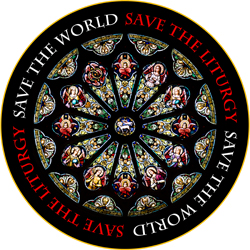And I had just decided I was going to learn what "stational" churches are.
But Fr Scott Haynes, the Guido Marini of the New World, explains it all for you... and for me.
So I am saved the effort!
Historically, on particular days the faithful of Rome would gather (or collect together) with the pope at a designated church called the ecclesia collecta [1] After the recitation of a prayer there, the assembly proceeded to another church referred to as the stational church. [2] In procession, they chanted the Litany of the Saints. At the stational church, as the pope began the celebration of Mass, he gathered the petitions of all the faithful into a unified prayer called the “collect”. ...
Over time, the Roman Missal eventually designated 86 stational days using 45 stational churches in the course of the liturgical year, with stations assigned on solemnities such as Easter and Christmas. [4] Most of the stational liturgies, however, occur during Lent. Pope Pius XI in 1934 made the most recent modification to the list of stational churches, adding Santa Agatha and Santa Maria Nuova. Rome’s stational liturgies slowly developed into this highly organized system, not only designating a specific church for each day of Lent, but also assigning specific liturgical propers (i.e., prayers, readings and choral chants) specially fit for each of these Lenten liturgies, as can be seen in the 1962 Missal of Blessed John XXIII. ...
The pope participated in the stational processions “accompanied by the entire clergy of the Lateran Basilica, [5] and by the high palace dignitaries, laymen, and clerics”. [6] The processional nature of the liturgy appeared in other places than Rome. By the 4th century, the Church in Jerusalem organized liturgical processions to bring worshippers to the Biblical Holy Land sites. In Constantinople, the emperor made a ceremonial procession through the palace and into Hagia Sophia, [7] in the company of the bishop — an image pointing to the rule of God and His Christ in the Heavenly Kingdom. ...
While processing to the station, the people chant the Litany of the Saints. The Church includes in that litany the stational saint of the day, whom the Church has selected as the icon of Christian virtue for our imitation. Thus, stational observance offers a magnificent way of venerating the saints.
The daily Mass propers of Lent generally refer to the stational saint or to some historical event associated with the place. For example, San Lorenzo in Luciana is the stational church for the third Friday of Lent. Historically, the Gospel that day is about the woman at the well, and San Lorenzo is located over the site of an old well. On the third Saturday of Lent, the epistle tells the Old Testament story of Susanna, and the Gospel recalls the woman caught in the act of adultery.In his book The Liturgical Year, Dom Prosper Gueranger, Benedictine Abbot of Solesmes, observed that the practice of the stational churches constituted a core Lenten practice in the monastic life of the Middle Ages: “Particularly on the Wednesdays and Fridays, processions used frequently to be made from one church to another. In monasteries, these processions were made in the cloister, and barefooted. This custom was suggested by the practice of Rome, where there is a ‘Station’ for every day of Lent which, for many centuries, began by a procession to the stational church”....
Under John Paul II, the Congregation for Divine Worship in 1988 stated that “the Roman tradition of the ‘stational’ churches can be recommended as a model for gathering the faithful in one place … at the tombs of the saints, or in the principle churches of the city or sanctuaries, or some place of pilgrimage which has a special significance for the diocese”. [23] And today our Holy Father Pope Benedict XVI reminds us, [24] “These rites retain their value, despite the passing of centuries, because they recall how important it also is in our day to accept Jesus’ words without compromises: ‘If any man would come after me, let him deny himself and take up his cross daily and follow me.’” ...
On the diocesan level, bishops today can designate certain churches as stational churches for Lent. If this were done, the people of a diocese would have a unique opportunity to make a mini-Lenten pilgrimage in the tradition of the Roman stational churches, to which an indulgence could be attached. It would provide an opportunity to highlight the importance of communal fasting, prayer and almsgiving.




No comments:
Post a Comment